These are the living history events of Spring/Summer of 2018 on my watch list.



These are the living history events of Spring/Summer of 2018 on my watch list.

Summer is always a very exciting time. The weather is great (for Denmark) and that lures people outside including many history enthusiasts. There are quite a few living history and collector events over the next couple of months and if I had more time I would visit them all. However time is a luxury I do not have enough of, so I wanted to create a list of events I am thinking about attending and perhaps other people could get inspired.
Copenhagen Medieval Market, June 3-5
Valbyparken in Copenhagen hosts a huge medieval market. It covers everything from the medieval period, from the vikings and to high medieval with shows, shops, food and fighting. Last year saw the visit of the Battle of the Nations medieval fighting teams. Copenhagen Historical Fencing Club (my HEMA club) will be present.
More info on: http://kmm.dk/?lang=en
I went there in 2015. It was a good day. I understand the blending with medieval fantasy is good for children but I found market a bit too commercial but still worth a visit.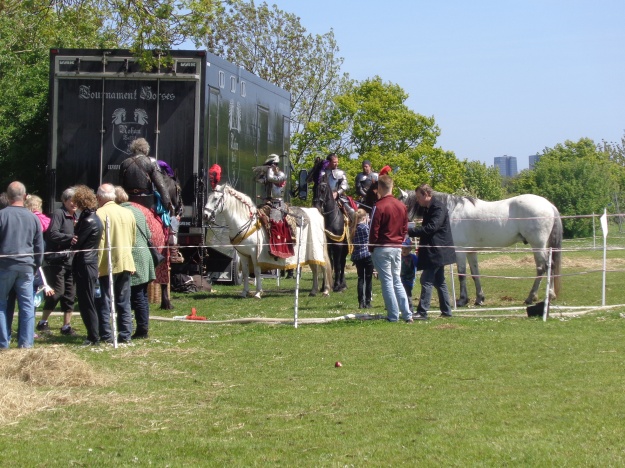
Græsted Veterantræf June 3-5 (UPDATE – Replaced by TimeWinder in Hundested)
It would seems like Græsted Veterantræf is replaced with TimeWinder see TimeWinder.DK. I do believe the content is the same.
While an event focused mostly on old vehicles a large number of these have military origins. I attended the show in 2015. The last couple of years have featured reenactor groups have put on a show with fighting over a German trench and quite a bit of blanks and smoke firing. I hope they will be back this year for I was truly impressed. But the program has not been published yet. Back then I was considering joining reenactment and I would love to but I simply do not have the time. More info can be found on: http://www.gvtf.dk/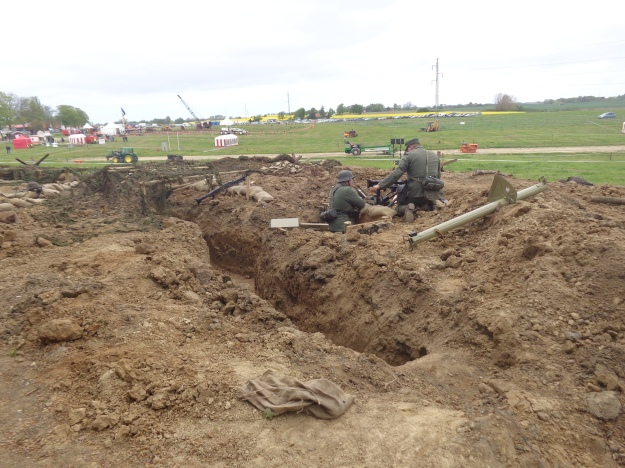
History Festival: 2000 Years of Military History June 17-18
Ejby Bunker houses a festival with several hundreds of reenactors from the Roman legions to Soviet special forces. It is hosted by Experience Centre: West Wall (Oplevelsescenter Vestvolden) which sits on part of the old defences of Copenhagen built in the 19-20th century.
Kampen om Als June 23-25 (main event on the night of June 24/25)
The Battle for Als was a battle fought during the 2nd Schleswig War of 1864. I have covered it in in more details in a blog post https://playinghistory.wordpress.com/2017/04/10/the-battle-for-als-1864-reenactment/
It is maybe not the most children friendly event as the event consists of a day of displaying camp life on both sides (Danish and German) with minor battles and shows. But the main event takes place at 2 am in the morning when the reenactors on time replay the battle that lost Denmark the war. I highly recommend going once, I had a tough weekend combining both the night firing at “Kampen of Als” with “Åben Hede” but both are well worth it.
For more info please also see: http://1864dage.dk/kampen-om-als/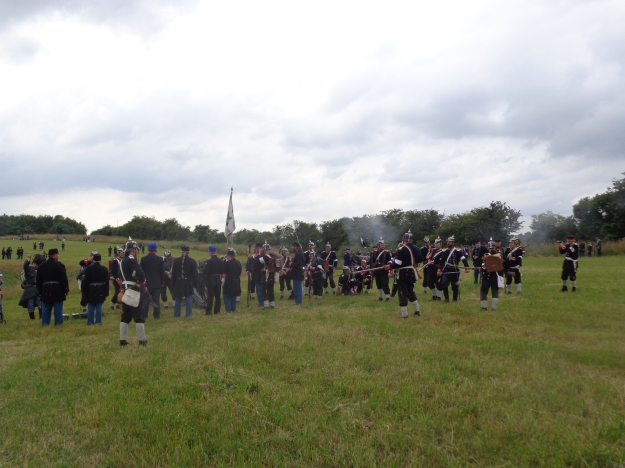
Åben Hede June 25
“Open Moor” is an event for the army and several collectors to show off what they have got. It is a mix of an exhibition as well as a day where the army does live firing exercises for the audience. It takes place on the moor around Oksbøl which is a military training ground.
If you have not heard the roar of tank fire, I strongly recommend going. Do bring hearing defenders, it can get loud. I went there in 2014 and it was unforgettable.
Classic Miliary Show 2017, August 14-20, Viborg
I have not attended Classic Military Show but from what I am told it is an event that takes place every other year. It is an event organised by a vehicle restoration group from the Jyske Dragonregiments Veteranpanser Forening. Please see: http://www.classicmilitaryshow.dk/
It is a mix of vehicle displays and reenactors. I very much intend to attend this year.

This post will likely be a bit of a commercial for an annual reenactment event taking place on the island of Als in June.
The Battle of Als is often forgotten in the larger scheme of things in Denmark as the final humiliation chapter in a lost war. In the Danish TV series “1864” it is passed over in a mere 15 seconds. It is quite different on the Prussian side where it is remembered fondly even in the musical piece by the famous composer Johann Gottfried Piefke in the “Alsenströmer March”.
Importance of the Battle
The storming of Dybbøl on April 18, 1864 sent shock waves through the Danish army and forced the evacuation of Fredericia which left most of Jutland in Prussian hands. It also forced the Danes to reconsider their stance come foward to the negotiation table. A month’s ceasefire was signed on May 18. The ceasefire was extended for another 14 days before the negotiations finally broke down as the Danes refused to yield more of the ducheries and believed they negotiated from a much stronger position than the military situation dictated. As in the First Schleswig War the Danes had relied on Fredercia and Dybbøl as toe holds in Jutland from which they could easily shift forces with their powerful navy but after having lost their bridgeheads the Danish army would have to stay defensive or land in force. But it also meant the Prussians could not improve their military situation much.
As hostilities resumed the Prussians had to decide on their next action as they clearly held the initiatve after the latest victories. With most of Jutland under Prussian control and the the next move would have to force a landing either on Fyn or Als. This was however made difficult by the strong Danish navy which on May 9th prior to the ceasefire had beaten the Austro-Prussian naval trask force at Helgoland. At first it was considered to attack both islands at the same time to split Danish forces but Als was decided on as the safer option.
The Battle
3 days after the ceasefire ran out on June 29th the Prussians launched a surprise attack on Als on the peninsula near the village of Kær. At 2 am the first attack wave of some 2500 Prussians, the attack was not preceded by an artillery bombardment and thus caught the defenders off guard. The defence was weak and poorly organized with only some 700 defenders spread out to guard the coastline and dig positions and thus were not prepared for battle, with some units being armed mostly with shovels having left their weapons in the village. More waves kept coming.
Around 3 am the Danish ironclad “Rolf Krake” appears in the strait sailing towards to sound of battle. For 45 minutes the ship held up the crossing of soldiers while engaging in a duel with Prussian batteries and the battle hung in the balance. But due to a misunderstanding the ship moved out of the narrow part of the strait in order protect any evacuation attempts as the Prussians seemed to have a firm foot hold. The captain of Rolf Krake was later court martialled but found not guilty as he would have had to move out of the narrow strait at first light to avoid extensive damage from the Prussian guns which would more easily range the ship in daylight. The battle continued for 4 hours until the Danes decided to retreat to the south of the island and initiate an evacuation. With the capture of Als the Prussians proved they were capable to crossing the straits thus the Danes could not rely on their navy for protection. Thus the Battle of Als forced the peace treaty which saw Denmark lose the ducheries of Schleswig, Holstein and Lauenburg.
Reenactment
Reenactment of the battle is an annual event and takes place this year June 23-25. I attended the reenactment in 2014 which was a major event given that it was also a 150 year anniversary but I have little doubt this year will be equally good. It takes place near the village of Kær near Sønderborg where the actual battle took place.
There will be a chance to experience camp life on both sides, Danish and Germans, and a large number of German reenactors also make their way to Kær.

German Reenactors parading on the camp ground
During the day skirmishes take place but all is up for the grand finale where the actual crossing and combat is acted out on the exact times. You have to be up late to catch it, the Prussians will be landing around 2 am and to get good views it is recommended to arrive early.

Foot, horse and artillery are all on display at the living history site
If this has got your interest, see http://kampenomals.dk/ for further information.
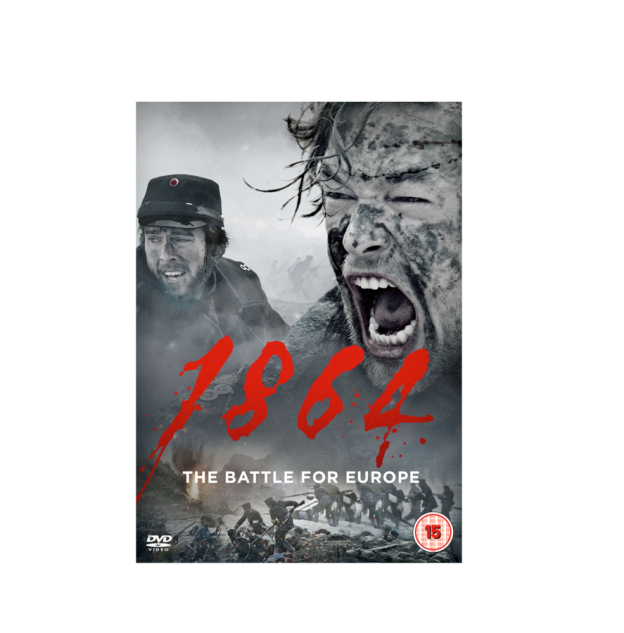
Considering the production history I did simply not think that this movie could be any worse than the TV-series, I was wrong, dead wrong. This is probably the worst historical movie I am going to review ever.
I do not even know where to start with my hate. This is a movie re-edit of the TV-series “1864” which was aired across Europe. It sparked a huge debate in Denmark for its wide historical inaccuracies, use of magic in a historical movie, banalities in the plot, pointless sidestories leading nowhere, silly cutting back and forth to modern day in order to politicise, helpless voice overs telling the viewer how to think and feel instead of showing and clear bias and modern moral ethics applied to 19th century characters. I understand the series was moderately popular in UK where most of the viewers I would assume would know nothing of the war of 1864 but in Denmark it was hugely critised. With so much debate in Denmark to learn from, I thought cutting an 8 hour long TV series to a 2 hour movie could perhaps still redeem it. There were many things in the TV series I did not like but I did have some good features as well. But clearly this cut has not given it any redeeming values, I do think it is because 2 hours is too short, a 3-3½ hour movie would probably have solved many of my problems with the movie. It must be said that the TV series was beautifully shot and the characters were generally interesting although almost carricated and warped ro fit modern stereotypes and thus as a time piece it utterly failed.
I feel the TV series was way too slow paced in the beginning and too fast paced in the end and generally cliche filled and had a touch of magic which really made it depart from much of its historical background. I was almost expecting the Baelrog to make an appearence and making the ordience understand that Danish nationalism was the true cause of their downfall.
I really wanted to think the movie could make it, it would cut out the magic and all the stupid side plots. The switching between 1864 and a present day narrator who had lost a brother in Afghanistan due to insensitive or nationalistic politicians sending boys off to fight for dubious causes really did not work and I thought that was going to disappear as well. So far so good….
Battle for Europe!
The Danish title is “Brothers in War” which I feel is much more fitting but the movie is titled Battle for Europe for the international market and makes a grand statement that the war was a precursor for World War I and this war changed Europe forever. That really pisses me off because that is twisting the truth in order to raise sales numbers. In what way is the battle over Southern Jutland anywhere near the battle for Europe? It is not that it is unimportant for Danish history nor that this was maybe the first attempt anyone had of stopping Prussian militarism but really how about the Austro-Prussian war or Franco-Prussian war which both followed within 6 years, now would any of these empires not have had a better chance than Denmark to stop the Prussians?
Unfortunately it is not a movie about the war at all, while there is fighting, there is no context or explanations as to what or why things are happening in the movie. There is no discussion of why the war started, any motivation for fighting the war and why the Prussians were even involved in an uprising in Denmark. There are two main battles portrayed and the retreat from the exposed positions at Dannevirke but there is no explanation and had I not studied Danish history it would make no sense at all. First we see the Danes beat off the Germans at Mysunde, next the Danes flee their forts in a chaotic rout because an officer said we need to retreat. But why oh why, please explain this otherwise it seems like somebody simply lost his head and decided to go lose the war singlehandedly, a David Lynch movie makes more sense than this nonsense. I mean even worse is the cutting at the main battle of the war in the middle when the two armies finally charged at each other. To me it would look almost like a stalemate and then cut to a field hospital scene with one of our recovering heroes, who won the battle, what is the time frame? The cut again and the girl have married someone else, no explanation or attraction this other character. I know in the series it is well explained but this movie cannot stand alone. The characters are one dimensional to an extent that I do not care about any of them, they are not people they are more like personification of human traits or faults and given a human body to walk around. There is no real character development either, again the TV series has it but the movie does not and thus miss out greatly. When Erasmus is killed the main character lets out a NOOOO which would have made Darth Vader proud, I felt nothing, but I never made a connection with the character. Erasmus was merely the stereotype “gentle giant turned killing machine against desperate odds and end up getting cowardly shot by opponents unwilling/unable to face him in close combat”.
Even worse, with all the possibilities to take in lessons from the TV-series and critical response, there are still plently of loose ends from things being cut from the TV series, even more things have been cut in half to save time but end up creating more loose ends.
I could perhaps recommend the TV series if you understand that you are in the fantasy realm of claiming to be history but the movie is horrendous.
1/10 I want my money back!

History is often all around us but often we are blind to it. A couple of days ago I finished my work day with a meeting at our HQ rather than the office building I am normally working from so I decided to take a walk through the park at Kastellet (the Citadel). There I came across an old momument. Kastellet used to house the GHQ of the Danish Army and thus it is not surprising to find military memorials, there are memorials to our fallen on international missions after WWII and one for our fallen in allied service during WWII but this one is rather special as it is not raised to Danish but Norwegian volunteer soldiers during the Schleswig Wars (fought between Denmark and the German Confederation). I think this is one of the untold stories and I would like to raise some awareness to and besides the Norwegians had some of the coolest rifles of the period.
I would like to cover more of the Schleswig Wars and Kastellet in later posts so I will not put a lot of emphasis on that during this post but the Kingdom of Denmark and the two Duchies of Holstein and Schleswig had for centuries been combined in a union. The Danish king governed Denmark but in his role as Duke of Schleswig and Holstein also rules these. Although power was concentrated in the same king different laws actually existed between the three parts of the kingdom. To make matters more complicated, Holstein the Southern most were predominately German, Denmark was Danish but Schleswig was a mix of Danish and German (although generally also split between a more Danish North and a German South). As nationalism swept through Europe in the 19th century these sentiments and the complicated situation tore the union apart. Denmark who received democracy in 1848 (but the Duchies did not) wanted to secure its position by integrating Schleswig and expelling the unruly Holstein which was totally unacceptable to the Germans and let to a rebellion in 1848 to 1850 known as the First Schleswig War. Being a combination of a civil war but also saw intervention by the German Confederation. Many German states tried to use the war to strengthen their position within the Confederation and Prussia openly supported the rebels with troops and weapons. The first war did only end due to international pressure on the Germans to stop supporting the rebels and the peace did not solve the issues over which the war had initially started. This led to the Second Schleswig War 1864 in which a much stronger German Confederation acted in support of Schleswig-Holstein rebels spurred up over Danish attempts to increase control with Schleswig. This was a very one sided affair and Denmark lost all of Schleswig not just the German part and Danish orientated Schleswig would stay German until 1920 when a vote finally settled the new border.
Norway and the Schleswig Wars
Norway and Denmark had for four centuries been joined in a union under the Danish king. With the rise of nationalism in Europe the rise of Scandinavism was a side-effect. It meant that Danes, Norwegians and Swedes did feel linked through common language and history (although having been at each other since the viking age). Despite having many disagreements there is a feeling of having more things in common than not, something that persists to this day.
Norway and Denmark had been forcibly split by the Napoleonic Wars, Denmark-Norway had supported Napoleon while Sweden had supported the allies and thus Norway was given to Sweden as part of the peace terms in 1814. When war broke out in 1848 many of the Danish officers were actually Norwegian by birth and born into what was then Denmark-Norway. In Norway were was great sympathy for Denmark and some 130 Norwegians volunteered to the Danish army and the Norwegian people gathered money for treatment of Danish wounded. The same thing happened in Sweden.
M1849/55 Kammerlader Rifle, a Norwegian Marvel
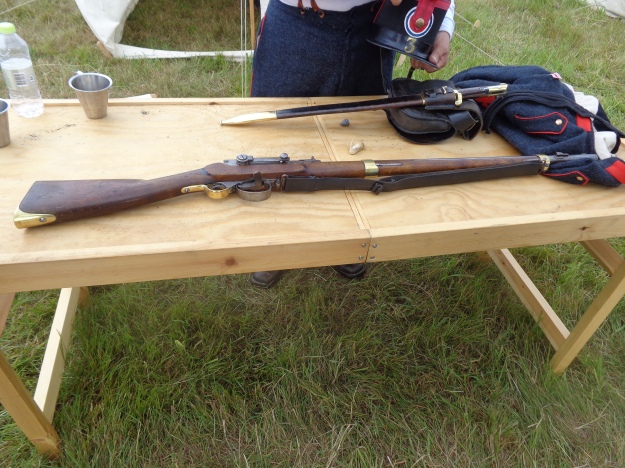
In 1864 an additional 100 Norwegians volunteered. Many of these brought their own weapons and some would have been issued with the Norwgian service rifle at that time the M1849/55 rifle. The first thing to notice is that it is a breech loading rifle which was in stark contrast to the Danish muzzle loaded rifle which was so outmatched by the Prussian breech loader. The Norwegian rifle was a percussion cap rifle much like most weapons of it time but it was an underhammer percussion cap gun which is what its name Kammerlader (chamber loaded) refers to. The idea was to have the hammer sit on the bottom side of the gun and strike up into the chamber to hit the cap and firing the gun.
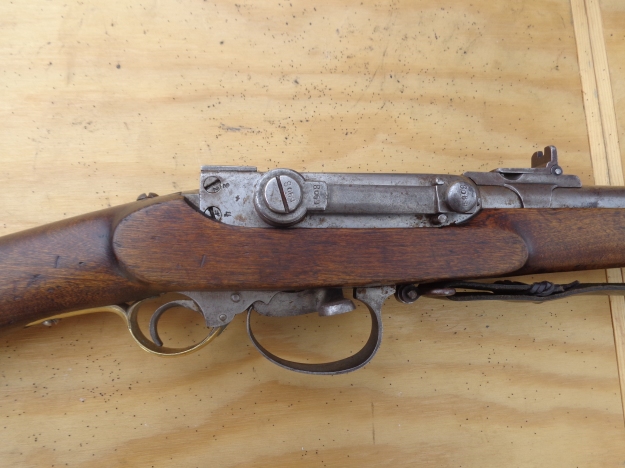
Note the underhammer (and guard) in front of the trigger
This means that the firing takes place inside the chamber which leaves as much cbetter aim as the shooter is not distracted by the cap going off close to his face. Furthermore when ambushing the spark from the cap would not give away the ambush until after the flash of the gun was visible. I am not sure that would have any measurable effect as the time from trigger to shot would likely be very short and not give much time to react but it is a good story.
This was quite a technological marvel of its day and something I think would be cool to mention.